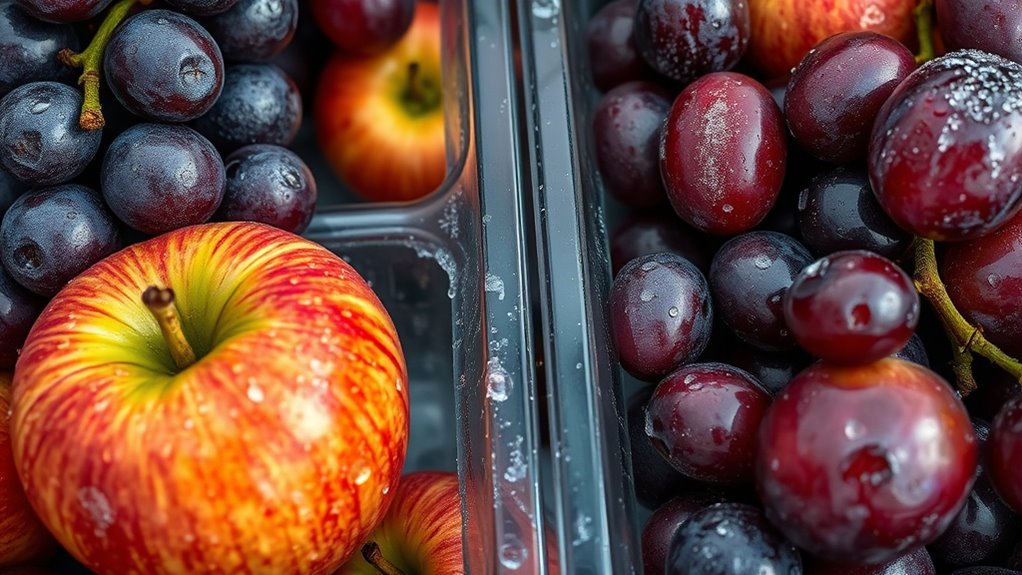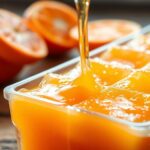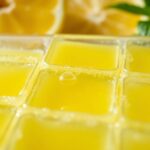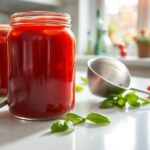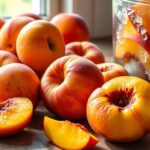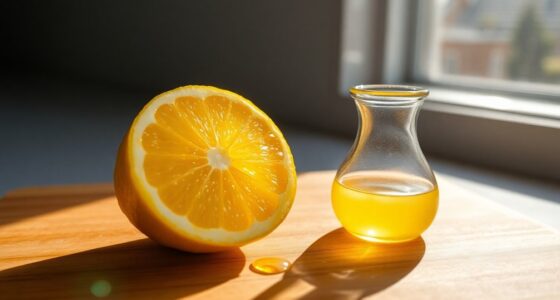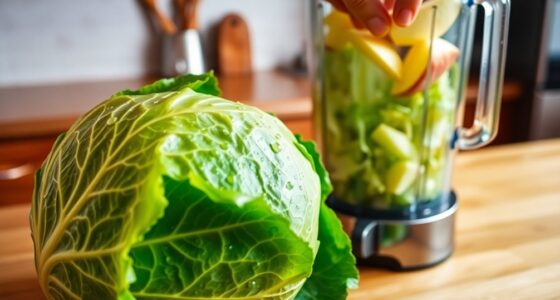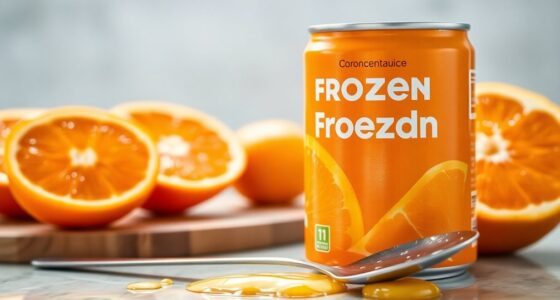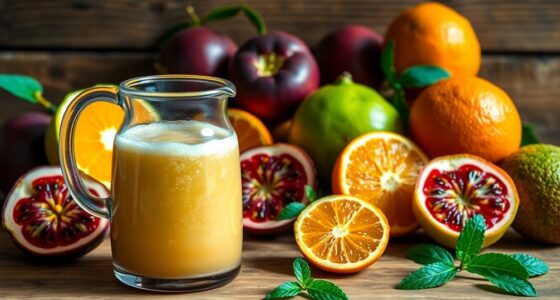To freeze excess produce for fall juicing, choose ripe, peak-season fruits and vegetables, wash thoroughly, and trim or peel as needed. Use flash freezing or pack in airtight bags to prevent freezer burn, and label with dates. Proper packaging and organization guarantee freshness and easy access later. Thaw slowly or blend straight from frozen for best results. Keep exploring to discover tips that maximize flavor, nutrients, and juice yield from your frozen bounty.
Key Takeaways
- Select seasonal, fully ripe produce, wash thoroughly, and cut into uniform pieces before freezing to preserve flavor and texture.
- Use flash freezing or individual quick freezing techniques with airtight packaging to prevent ice crystal damage.
- Label containers with dates and organize produce by type for easy access and to prioritize older items.
- Thaw frozen produce gradually in the refrigerator or cold water for best juicing results; blending straight from frozen is also effective.
- Proper freezing preserves nutrients, flavor, and freshness, ensuring high-quality ingredients for fall juicing routines.
Selecting the Best Produce for Freezing
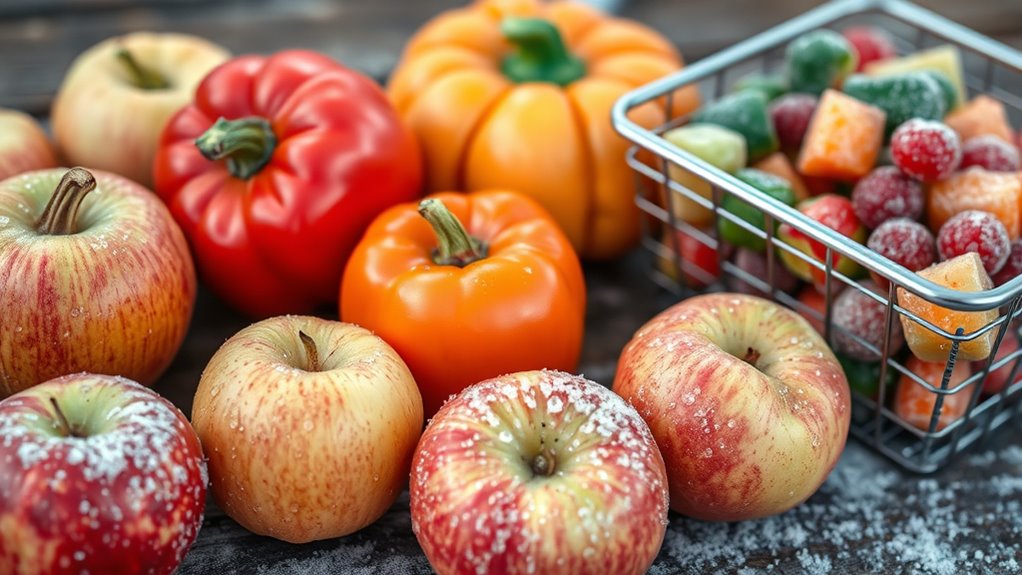
Choosing the right produce is essential for successful freezing. Start with a seasonal selection to ensure maximum freshness and flavor. Fruits and vegetables harvested at their peak ripeness typically have the best taste and texture after freezing. When evaluating quality, look for firm, unblemished produce without soft spots or signs of spoilage. Avoid produce with bruises, mold, or excessive blemishes, as these issues can worsen during freezing and storage. Freshness is key; produce that’s already starting to spoil won’t freeze well and will compromise your final product. Remember, high-quality produce maintains its nutritional value and flavor better when properly selected. Proper storage techniques are also crucial to preserve quality during freezing, so ensure your produce is prepared and packaged correctly. Taking the time to choose the best items will make your future juicing and recipes much more enjoyable. Additionally, understanding freezing methods that help retain nutrients can elevate your results. Using appropriate packaging materials can also prevent freezer burn and extend shelf life. Implementing proper blanching techniques can further improve preservation and nutrient retention during freezing. Being aware of nutrient retention strategies can make a significant difference in the nutritional quality of your frozen produce.
Preparing Your Fruits and Vegetables for Freezing
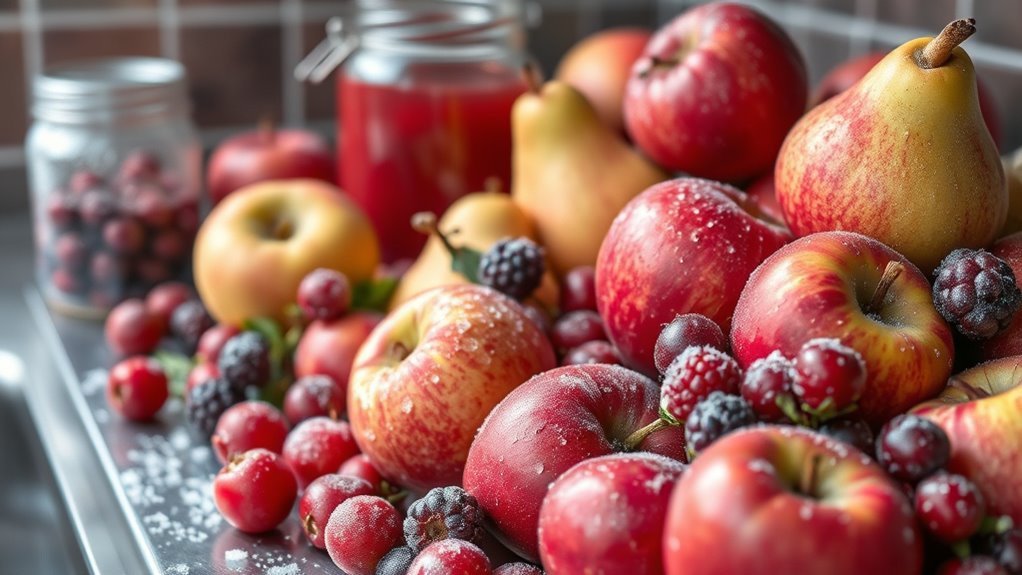
Before freezing, it’s important to thoroughly wash and prepare your produce to guarantee quality and safety. Start by evaluating fruit ripeness; choose fruits that are fully ripe but not overripe, ensuring they retain flavor and nutrients when frozen. For vegetables, select fresh, healthy specimens without bruises or blemishes. Properly cleaning your produce removes dirt, bacteria, and pesticides, which is essential before freezing. Trimming, peeling, or cutting fruits and vegetables into uniform pieces promotes even freezing and easier use later. Blanch vegetables briefly to halt enzyme activity, preserving color, texture, and flavor. Proper blanching times are crucial for maintaining vegetable quality during storage. For fruits, consider pre-treating with lemon juice to prevent browning. Additionally, understanding self watering plant pots can help you keep your plants healthy and thriving while you focus on your produce. Using freezing techniques can further improve the preservation process, helping your fruits and vegetables stay fresh longer. Taking these steps ensures your produce stays fresh, nutrient-rich, and ready for juicing when you need it, and understanding road sign safety can help you navigate your local markets more confidently when sourcing produce. Additionally, using the right survival gear can help you handle unexpected situations while sourcing or transporting your produce.
Choosing the Right Freezing Method for Juicing Ingredients
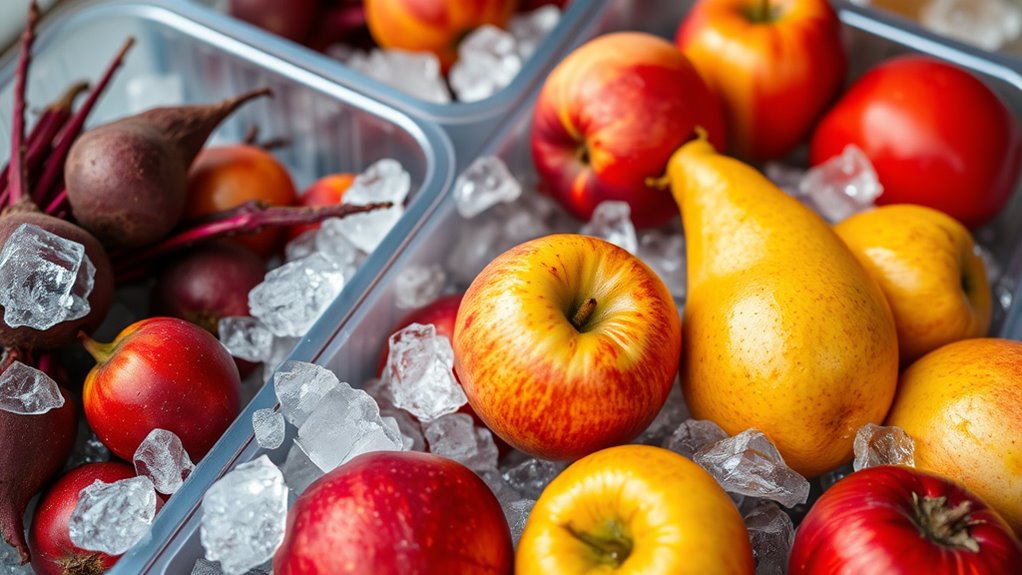
Once your fruits and vegetables are properly prepared, selecting the right freezing method can make a big difference in maintaining their quality for juicing. Different freezing methods, like flash freezing or traditional bulk freezing, impact how well your produce retains flavor, texture, and nutrients. Flash freezing quickly freezes individual pieces, preventing ice crystals from damaging cell walls, which helps preserve ideal storage quality. Proper freezing techniques can also help retain the nutrients in your produce, ensuring your juices remain healthy and flavorful. Additionally, understanding freezing best practices can optimize preservation and reduce waste. Choosing the appropriate method based on your usage can also minimize oxidation and spoilage, further extending shelf life. Moreover, employing freezing best practices can optimize preservation and reduce waste.
Proper Packaging to Preserve Flavor and Nutrients
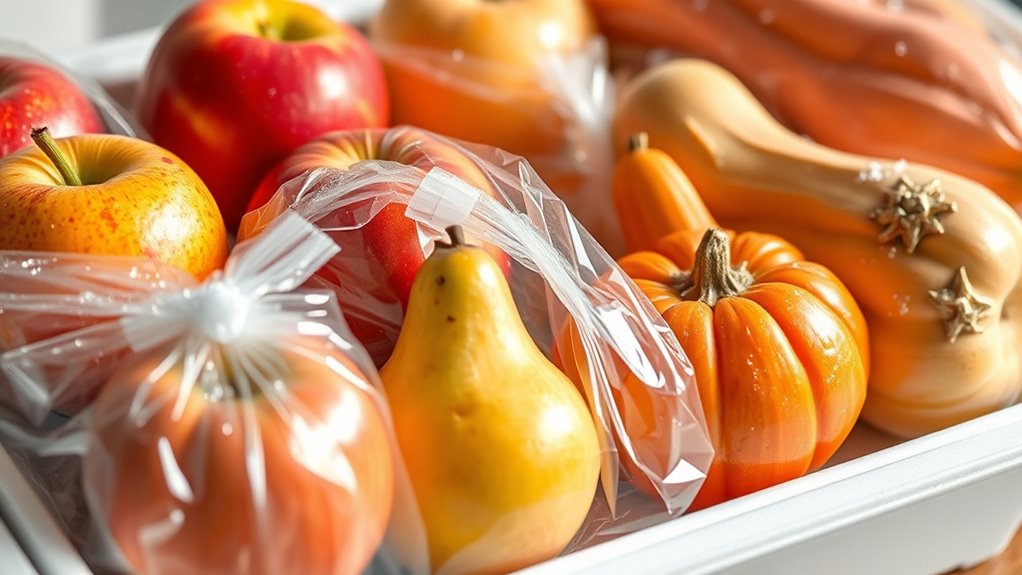
Proper packaging is essential for maintaining the flavor and nutrients of your frozen produce. Using airtight containers or heavy-duty freezer bags helps prevent freezer burn, which can degrade flavor preservation and nutrient retention. Remove as much air as possible before sealing to minimize oxidation. Consider portioning produce into single-use sizes to avoid repeated thawing, which can diminish quality. Label each bag or container with the date to track freshness and ensure you use older items first. Using vacuum-sealing devices offers an extra layer of protection, locking out air and moisture. Proper packaging not only preserves the vibrant flavors but also retains the maximum nutrients, ensuring your frozen produce remains as nutritious and flavorful as when it was fresh. Additionally, choosing high-quality storage materials can further enhance the preservation process and prevent spoilage. To further safeguard your produce, store items at consistent temperatures to prevent freezer burn and temperature fluctuations that can compromise quality. Regularly check your freezer to ensure optimal temperature control and prevent spoilage.
Labeling and Organizing Frozen Produce
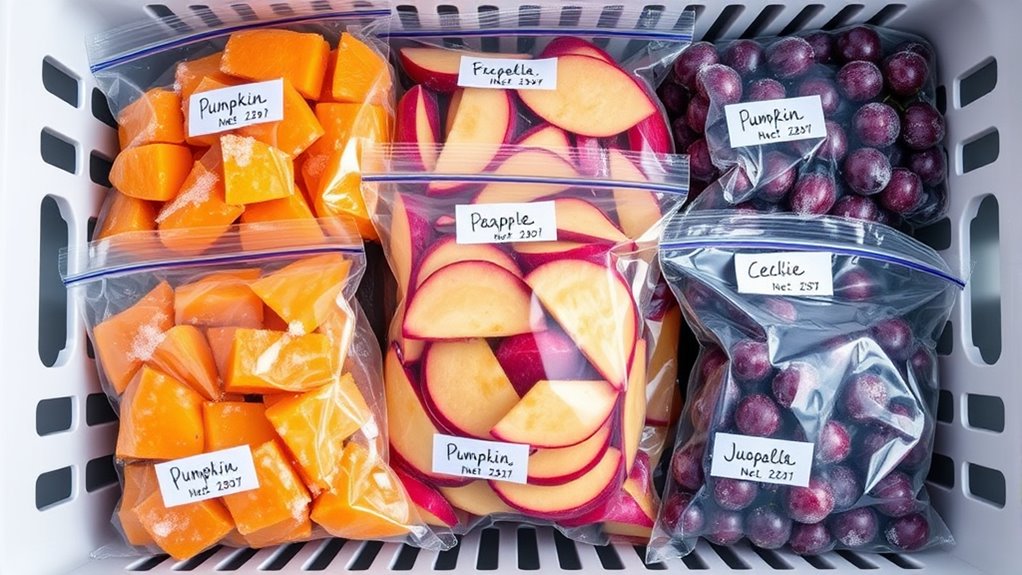
How can you keep your frozen produce organized and easy to find? Start by using labeling essentials, like clear markers and waterproof labels, to identify each bag’s contents and date. Organizing storage is key—group similar items together, such as berries or squash, and place older items in front for easy use. Consistent labeling prevents confusion and saves time, especially when juggling multiple produce types. Use a dedicated freezer section or baskets to keep everything tidy and accessible. Remember to include the harvest or freezing date on each label to track freshness. Regularly review your organized storage, discarding expired or freezer-burned items. Incorporating storage solutions such as bins or baskets can further optimize space and improve accessibility. Additionally, utilizing proper labeling practices helps maintain an organized system that’s easy to manage over time. Proper labeling and organization guarantee you can quickly grab what you need for juicing, reducing waste and maintaining freshness. Moreover, understanding cost management principles can help in budgeting for supplies like labels and storage containers to optimize your freezing process. Keeping a consistent system ensures long-term success and minimizes the frustration of searching through your frozen items.
Thawing Techniques for Maximum Juice Yield
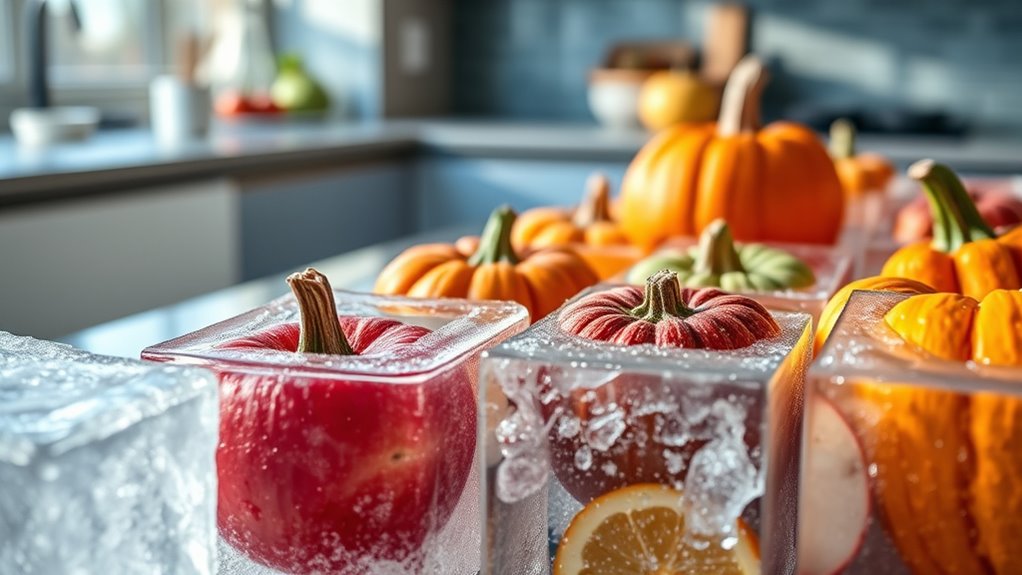
To maximize juice yield from your frozen produce, choosing the right thawing method makes a significant difference. Proper thawing techniques help retain moisture and nutrients, ensuring you get the most juice possible. Consider these methods:
Choosing the right thawing method preserves moisture and nutrients, maximizing your juice yield from frozen produce.
- Gradually thaw in the refrigerator overnight for even, controlled thawing.
- Use cold water baths for faster thawing, sealing produce in waterproof bags.
- Microwave briefly on defrost setting for quick thawing, but monitor closely.
- Avoid thawing at room temperature to prevent bacterial growth and juice loss.
- Employing safe thawing practices aligns with AI security principles to ensure data integrity and food safety.
Tips for Blending and Juicing Frozen Ingredients
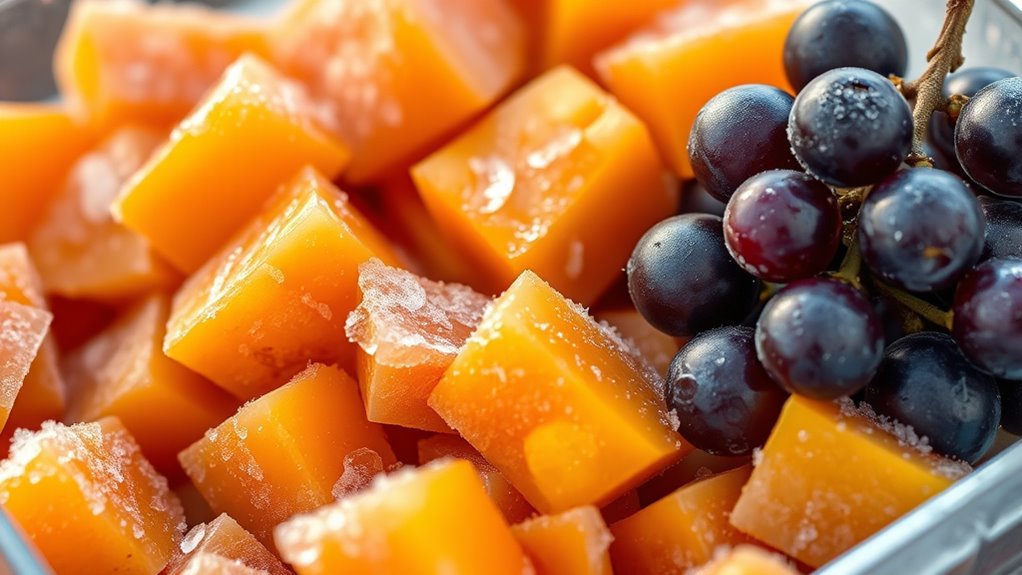
When blending or juicing frozen ingredients, proper preparation makes a big difference. You should consider thawing or softening items to improve texture and extraction. Using the right techniques guarantees you get the most flavor and nutrients from your frozen produce.
Thawing and Preparation
Thawing and preparing frozen produce properly can make a significant difference in how well it blends or juices. Using the right defrosting techniques helps preserve texture and flavor. To guarantee quality, consider these tips:
- Slow thaw in the fridge: This gentle method maintains texture preservation and prevents over-softening.
- Use cold water bath: For quicker thawing, submerge sealed bags in cold water, changing it regularly.
- Microwave briefly: Use the defrost setting for small portions, but be cautious to avoid partial cooking.
- Prepare directly from frozen: For smoothies or juices, sometimes it’s best to blend straight from the freezer to retain nutrients.
Proper thawing ensures ingredients blend smoothly without becoming too watery or mushy, resulting in better-tasting, nutrient-rich juices.
Blending Techniques
Blending frozen ingredients directly can be a game-changer for achieving smooth, nutrient-rich juices and smoothies. When you blend frozen produce, you naturally enhance the texture, creating a creamier and more satisfying drink without extra ice or thickening agents. This process also promotes better flavor infusion, as the cold helps release the natural sugars and aromas, boosting overall taste. To maximize these benefits, start blending at low speed and gradually increase to high, allowing the ingredients to break down evenly. Adding a splash of liquid—water, juice, or milk—can improve texture and aid blending. Keep an eye on consistency, and don’t hesitate to pause and scrape down the sides of your blender. This approach ensures a smooth, flavorful drink every time.
Combining Different Produce for Unique Flavors
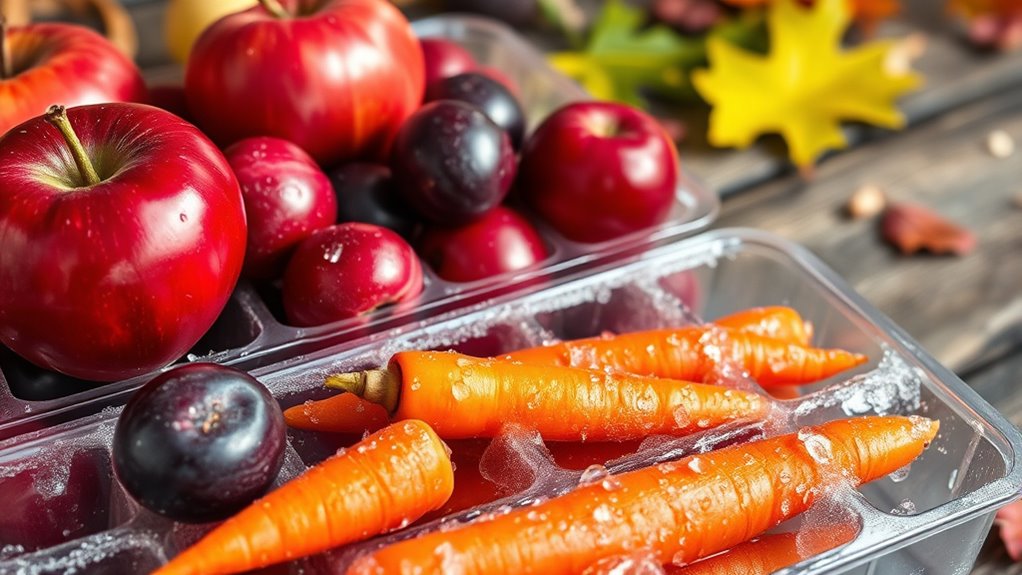
Experimenting with different produce combinations can create exciting flavor profiles for your juices. You’ll want to balance sweet and tart elements to keep the flavors vibrant and revitalizing. Trust your taste buds to find the perfect pairings that suit your palate.
Flavor Pairings for Juicing
Creating unique juice flavors starts with thoughtful pairing of produce that complement each other’s natural tastes. To develop appealing seasonal flavor combinations, focus on complementary taste profiles that enhance the overall flavor. Here are some ideas to inspire your juicing mix:
- Combine sweet apples with tart cranberries for a tangy, invigorating blend.
- Pair ripe peaches with zesty ginger for a warm, spicy twist.
- Mix earthy beets with citrus oranges to brighten the flavor.
- Use juicy pears with aromatic mint for a cooling, fragrant taste.
Balancing Sweet and Tart
Balancing sweet and tart flavors is key to crafting juices that excite the palate without overpowering it. Achieving the right sweet balance and tart contrast makes your juice both invigorating and complex. To experiment, consider combining produce like apples with citrus or berries with green apples. Use this table as a guide:
| Sweet Ingredient | Tart Ingredient |
|---|---|
| Apples | Lemons or limes |
| Pears | Cranberries or raspberries |
| Mango | Green or unripe melon |
Mixing these in different proportions allows you to customize flavor profiles. Remember, too much tartness can be jarring, while excessive sweetness may dull the palate. Aim for harmony by balancing these flavors to create a vibrant, well-rounded juice.
Safety Tips and Best Practices for Freezing Produce
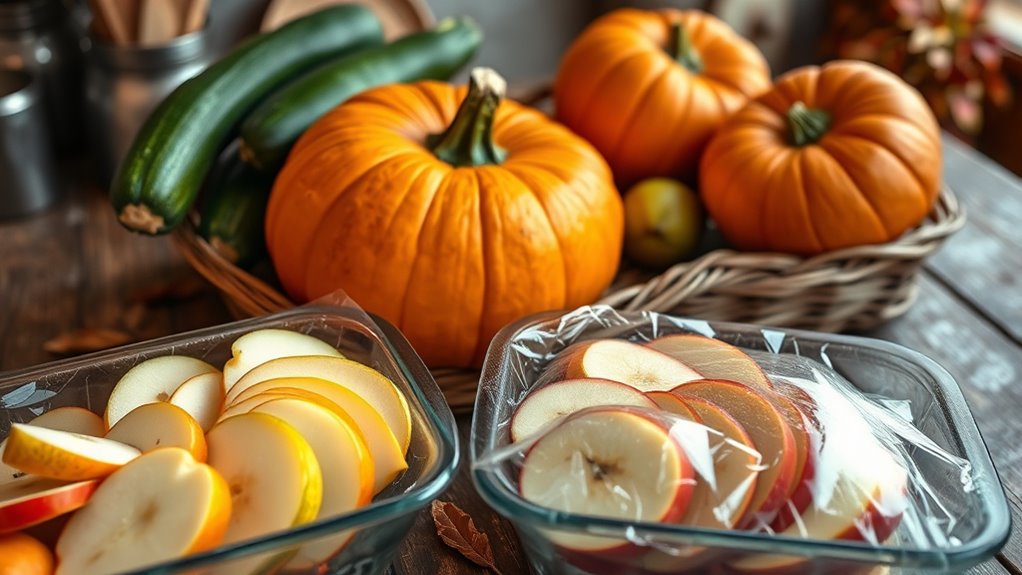
Freezing produce safely requires attention to proper handling and storage techniques. To guarantee food safety and quality preservation, follow these steps:
Proper handling and storage keep your produce safe and fresh when freezing.
- Wash your produce thoroughly with cold water to remove dirt and bacteria.
- Blanch fruits and vegetables when necessary, as it helps kill bacteria and enzymes that can degrade quality.
- Use airtight containers or freezer-safe bags to prevent freezer burn and contamination.
- Label each package with the date to monitor freshness and ensure you use older items first.
Always keep your freezer at 0°F (-18°C) to maintain ideal food safety. Properly prepared and stored produce preserves flavor, nutrients, and texture, making your fall juicing both safe and delicious.
Frequently Asked Questions
How Long Can I Store Frozen Produce for Optimal Juicing Quality?
You can store frozen produce for about 8 to 12 months to maintain ideal juicing quality. Proper storage duration is key to preserving flavor, texture, and nutrients. Keep your produce in airtight containers or freezer bags to prevent freezer burn and moisture loss. After this period, the quality may decline, affecting your juicing results. For the best taste and nutrients, use frozen produce within the recommended timeframe.
Can I Freeze Cooked or Processed Produce for Juicing Later?
Yes, you can freeze cooked or processed produce for later juicing, but keep in mind that different cooking methods can affect flavor retention. Steaming or blanching helps preserve nutrients and flavor better than boiling. When you freeze, package the produce tightly to prevent freezer burn. Be aware that cooked produce may have a softer texture, which can make juicing a bit messier, but it’s still a good way to save excess produce.
Does Freezing Affect the Nutritional Content of Fruits and Vegetables?
Think of your fruits and veggies as a precious book; freezing is like closing it carefully so pages stay intact. Freezing impact on nutrient retention is minimal if you store produce properly. While some water-soluble vitamins might slightly decrease, most nutrients remain, preserving flavor and health benefits. So, you can confidently freeze excess produce, knowing it keeps most of its nutritional value until you’re ready to juice.
Are There Specific Fruits or Vegetables That Don’t Freeze Well for Juicing?
You wonder if some fruits or vegetables don’t freeze well for juicing. Usually, freezing delicate berries like strawberries or raspberries can cause cell damage, leading to a mushy texture when thawed. Similarly, freezing high water vegetables such as cucumbers or lettuce often results in sogginess and reduced juicing quality. To preserve peak flavor and texture, consider freezing these produce types carefully or using alternative preservation methods.
How Can I Prevent Freezer Burn on My Produce?
Prevent freezer burn by properly packing produce in airtight packaging, sealing out air and moisture. Label each package clearly so you know what’s inside and when you froze it. Always remove as much air as possible to prevent frost from forming. Keep your freezer at the right temperature, typically 0°F, to maintain freshness. Following these simple steps safeguards your produce, saving you from soggy, freezer-burned fruits and vegetables.
Conclusion
Freezing excess produce is like capturing sunshine in a jar, ensuring you have vibrant, fresh flavors ready whenever you need them. By selecting quality fruits and veggies, preparing them properly, and following best freezing practices, you’ll unseal the full potential of your harvest. With a little effort, your fall bounty can become a treasure chest of delicious juices all year round—turning everyday ingredients into nature’s sweetest magic.
Susannah expertise lies in researching and compiling evidence-based content on juicing, nutrition, and overall health. She is committed to ensuring that The Juicery World offers accurate, up-to-date, and trustworthy information to empower readers to take control of their health. Susannah’s goal is to inspire individuals to embrace juicing as a way to nourish their bodies and live their best lives.

